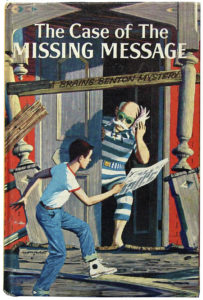 Golden Press, an imprint of Western Publishing, put out a lot of juvenile fiction in the 1940s, ’50s, and ’60s. In the area of juvenile mystery/adventure series, they tried to compete with Grosset & Dunlop and Simon & Schuster with a few of their own series, including Trixie Belden, Ginny Gordon, the Power Boys, Lassie, and the Brains Benton series. Brains Benton is in many ways the last hurrah for Golden’s juvenile series.
Golden Press, an imprint of Western Publishing, put out a lot of juvenile fiction in the 1940s, ’50s, and ’60s. In the area of juvenile mystery/adventure series, they tried to compete with Grosset & Dunlop and Simon & Schuster with a few of their own series, including Trixie Belden, Ginny Gordon, the Power Boys, Lassie, and the Brains Benton series. Brains Benton is in many ways the last hurrah for Golden’s juvenile series.
It only lasted six volumes, from 1959-61. The first story was written (and credited) to Charles Spain Verral. Probably best known to pulp fans as a main writer for the Bill Barnes series, he later got into writing various juvenile books for Golden. He then turned the series over to another author, and the rest of the series was published under the name of “George Wyatt.” But apparently things didn’t work out, and Verral soon took back the series. He later said he pretty much wrote the whole series. All appeared in picture cover format (hardcovers with artwork part of the cover, no dust jackets). Only a couple were reprinted in paperback.
The focus of the series was young teenagers Barclay “Brains” Benton (“X”) and sidekick James “Jimmy” Carson (“Operative Three”) who live in the fictional town of Crestwood.
Brains is your typical, for the time, young electronics genius. His parents teach at Crestwood College, his father a professor, his mother an art instructor. Jimmy is your average boy, more the leg man, and is the narrator of the stories. Their age is unclear, but not old enough to drive, this puts them on par with the 3 Investigators. On their own, they form the “Benton and Carson International Detective Agency.” The local police chief doesn’t care for their meddling, so they solve all their cases on their own without any sort of official or semi-official capacity as with other juvenile mystery series. This brings a bit of gravus to the series, unlike others. And it’s enhanced by the array of interesting characters.
The series is:
- The Case of the Missing Message (1959)
- The Case of the Counterfeit Coin (1960)
- The Case of the Stolen Dummy (1961)
- The Case of the Roving Rolls (1961)
- The Case of the Waltzing Mouse (1961)
- The Case of the Painted Dragon (1961)
The last story, The Case of the Painted Dragon, is probably an excellent example of this series. They get involved with a mystery that’s gone on for a while. A sinister man is asking about a Japanese boy, but there is none in town. Brains and Jimmy soon find and befriend this boy who moves into town. His parents had lived in Crestwood before dying in an accident several years prior. Turns out is all tied to a much larger mystery of a lost pearl necklace. The Japanese family is searching for it, to help restore their fortune. But others are after it as well. Will the two solve the mystery and restore a family’s fortune?
Now, what I think is interesting is that unlike other short-lived series, there seems to be quite a bit of interest today in this series, such that we have new (if unauthorized) novel-length stories with these characters.
Charles E. Morgan III has put out a dozen novels and short stories with the characters, as a continuation of the series. Scott Lockwood has written both stories that are a continuation, as well as others were the boys are now at Crestwood College. And there are two to three others who have done one or two novels as well, some with them as adults, others as juveniles. Many of these have been published in book form and are available for sale from Amazon and other places.
There are also a couple of websites devoted to Brains Benton, such as the Brains Benton Anthology.
I do wish someone could get the rights to reprint the six original stories.




I read the series as a kid. I remember Brains Benton also had a secret headquarters (over the family garage, I think) full of spy equipment and such. Entrance was by a secret, automatic door.